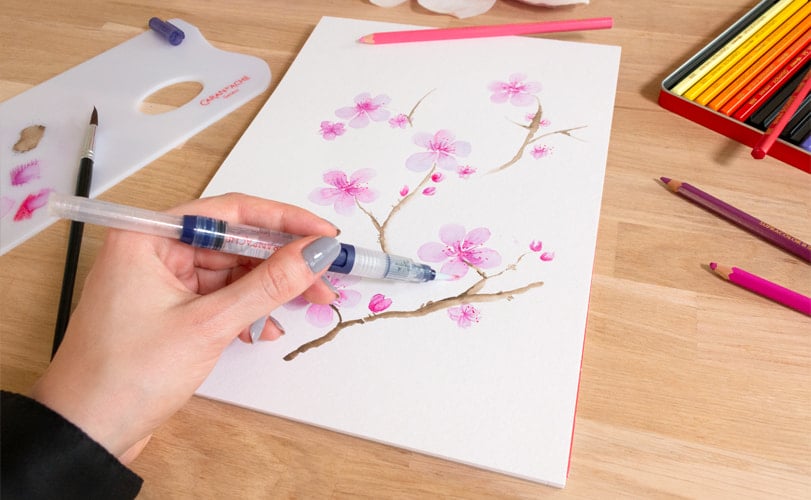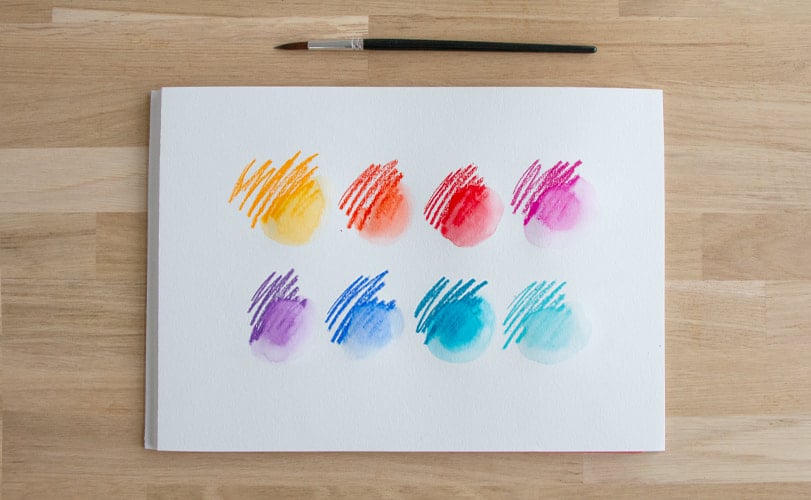Our colour and writing products are manufactured in our workshops in Geneva since 1915.
- FREE ENGRAVING UNTIL JANUARY 5TH, 2025 INCLUDED ON OUR HAUTE ÉCRITURE COLLECTIONS.
- FREE GIFT WRAP AND PERSONALIZED MESSAGE. FREE DELIVERY ON ORDERS OVER 60€.
WATERCOLOR: OUR TIPS FOR BEGINNERS
Watercolor stand out with their transparency and ability to subtly catch nuances of color. Are you a beginner who loves to draw and paint? Or an experienced artist who would like to try new artistic techniques? Either way, let yourself be tempted by watercolor.
Here are our tips for choosing your supplies, from the choice of paper to the type of paintbrush, and learning to mix your colors. With Caran d'Ache pencils and other watercolour mediums, express your creativity and let your imagination loose with watercolor.
Here are our tips for choosing your supplies, from the choice of paper to the type of paintbrush, and learning to mix your colors. With Caran d'Ache pencils and other watercolour mediums, express your creativity and let your imagination loose with watercolor.
ESSENTIAL SUPPLIES YOU'LL NEED FOR PAINTING WITH WATERCOLOR
• Watercolor paper: choose a type of paper specially designed for watercolor painting, made with 100% cotton and heavy enough (at least 300 gsm) to prevent the paper from warping when wet.
• Paintbrushes conceived for watercolor paints. Choose paintbrushes made with natural bristle or synthetic fibers.
• Water-soluble coloring pencils or pastels such as the Neocolor™ II Aquarelle range.
• A palette to mix your colors.
• Water for cleaning your paintbrushes and diluting the paint.
• A drawing board or easel for support.
• Paintbrushes conceived for watercolor paints. Choose paintbrushes made with natural bristle or synthetic fibers.
• Water-soluble coloring pencils or pastels such as the Neocolor™ II Aquarelle range.
• A palette to mix your colors.
• Water for cleaning your paintbrushes and diluting the paint.
• A drawing board or easel for support.

🎨 Colors you will need when starting watercolor
No need to invest in a wide range of colors when starting out. The three primary colors will be enough for you to learn the basics: blue, red and yellow. Choose two or three shades for every primary color, in both warm and cool tones. You will then be able to mix these three basic pigments to create new colors and produce unique watercolor paintings.

Unlike other paints such as gouache, watercolor does not need to have white added to it as the paper plays that role.
Tip for beginners: choose a ready-to-use watercolor palette.
CARAN D’ACHE WATER-SOLUBLE COLOR PENCILS: AN INNOVATIVE ALTERNATIVE TO TRADITIONAL PAINT
Caran d’Ache has developed different ranges of water-soluble media, most notably water-soluble color pencils. Each pencil is made up of pigments that dissolve when they come into contact with water and thus allow you to reproduce the watercolor effect.
Water-soluble pencils look just like ordinary color pencils but are different in that they can also be used with water to create watercolor effects. If you’re just beginning watercolor the pencils are an excellent choice as they are easy to use. You can also take them with you everywhere you go.
Water-soluble pencils look just like ordinary color pencils but are different in that they can also be used with water to create watercolor effects. If you’re just beginning watercolor the pencils are an excellent choice as they are easy to use. You can also take them with you everywhere you go.

The Museum Aquarelle range is Caran d’Ache’s emblematic range of water-soluble color pencils that inspires professional artists and all lovers of watercolor. These top-of-the-range water-soluble color crayons are made in Switzerland from the best-quality pigments that offer deep colors and exceptional transparency.
MIXING WATERCOLORS
Start by becoming familiar with the color wheel to understand the relationship between primary colors and complementary colors.
Top tip: mixing complementary colors will create neutral colors.
The more water you add, the lighter and more transparent the color will be.
• To create subtle transitions, lightly dampen the area of your palette where you plan to mix your colors. You can also moisten the sheet of paper before applying the colour to obtain smooth gradients.
• To mix colors directly on the paper, apply a color on an area of the paper, then clean your paintbrush and apply the second color you’d like to use. Apply this color next to the first and use your paintbrush to gently blend the two colors where they meet.
Top tip: mixing complementary colors will create neutral colors.
The more water you add, the lighter and more transparent the color will be.
• To create subtle transitions, lightly dampen the area of your palette where you plan to mix your colors. You can also moisten the sheet of paper before applying the colour to obtain smooth gradients.
• To mix colors directly on the paper, apply a color on an area of the paper, then clean your paintbrush and apply the second color you’d like to use. Apply this color next to the first and use your paintbrush to gently blend the two colors where they meet.

WHICH MEDIUM FOR WATERCOLOR PAINTING?
Watercolor paper is specifically designed to soak up water and watercolor paint. Different types of paper exist, each with different weights and textures, such as fine grain, satin grain or rough/torchon grain. Opt for paper made out of pure cotton which absorbs the water best.

You can also use watercolor cardstock, which is thicker than paper and often used to create cards or illustrations.
If you’d like to experiment with new textures or new techniques, why not try a watercolor canvas board ? Watercolor canvas is coated in a specific primer that fixes the watercolor.
The medium used can influence the appearance of your painting.
If you’d like to experiment with new textures or new techniques, why not try a watercolor canvas board ? Watercolor canvas is coated in a specific primer that fixes the watercolor.
The medium used can influence the appearance of your painting.
WATERCOLOR PAINTING IDEAS FOR BEGINNERS
If you're just starting watercolor, concentrate on simple patterns such as geometric shapes, featureless landscapes, flowers or small motifs. As a beginner, you should focus on exploring basic watercolor techniques, play with color and develop your sense of composition. Take time to see how the colors are absorbed by the paper and interact together and with water.


Mastering watercolor requires regular practice. Experiment, create and explore your creative side by working with various media and trying different techniques.
Would you like to improve your technique and follow watercolor classes? Discover the Creative Class by Caran d’Ache where you'll find videos and online exercises to help you improve your drawing and painting skills with advice from passionate artists.
Free from 60€ purchase.
Possible return under 14 days.
Possible return under 14 days.
Visa, Mastercard, Paypal.
Monday to Friday from 10am to 7pm and Saturday from 10am to 5pm.
+41 (0) 848 558 558
(Calls from Switzerland : at local rate. Calls from abroad : at telecom provider’s international rate.)
+41 (0) 848 558 558
(Calls from Switzerland : at local rate. Calls from abroad : at telecom provider’s international rate.)

 Deutschland
Deutschland Austria
Austria Belgium
Belgium Etats-Unis
Etats-Unis France
France Italy
Italy Japan
Japan Netherlands
Netherlands United Kingdom
United Kingdom Switzerland
Switzerland